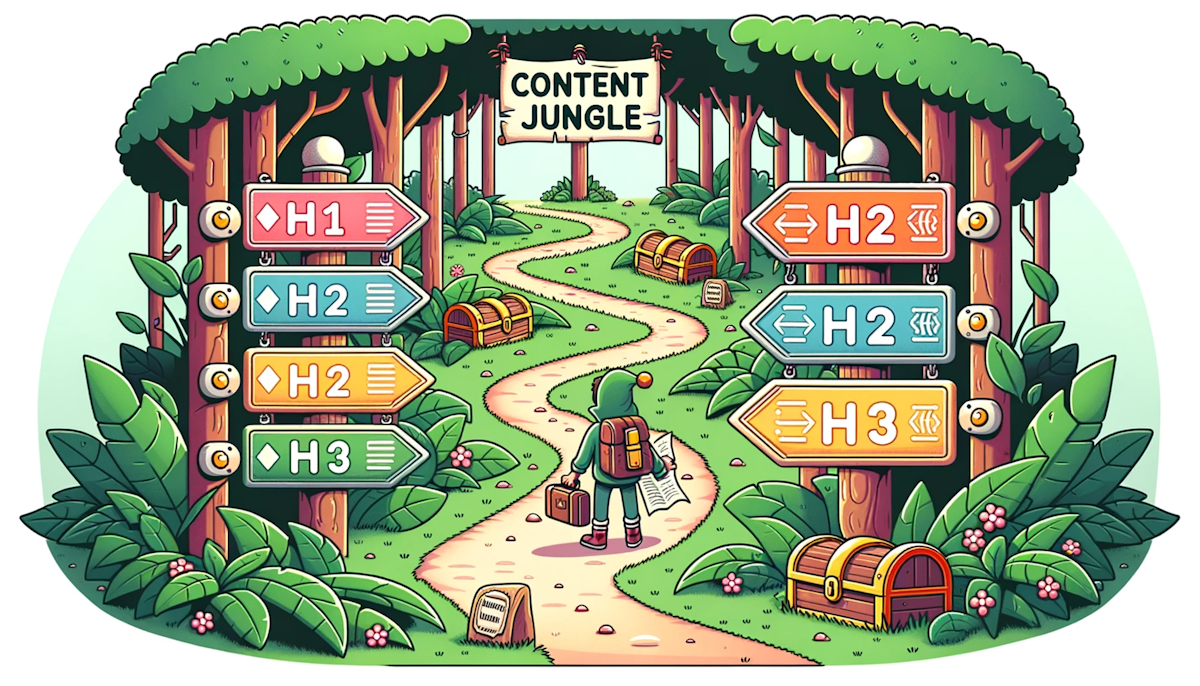Optimizing Headings and Subheadings for SEO in Blog Posts

In the ever-evolving world of digital content, crafting an engaging and SEO-friendly blog post is a fine art. One crucial aspect that often takes center stage is the art of optimizing headings and subheadings.
These seemingly humble elements of your blog structure play a pivotal role in enhancing the readability of your content, guiding readers through your ideas, and boosting your search engine rankings.
In this blog post, we will delve into the intricacies of heading optimization, exploring how to create compelling headings, the importance of a logical heading hierarchy, and the tools at your disposal to analyze and refine your heading strategies.
The Hierarchy of Headings

HTML heading tags, denoted as H1, H2, H3, and so forth, serve to structure and organize content on a webpage. These tags represent a hierarchy, with H1 being the highest level and typically used for the main title or topic of the page.
H2 tags are employed to subdivide the content into sections, and H3, H4, and so on, are used to further subdivide and nest content within each section. This hierarchical structure not only provides visual clarity but also helps search engines and screen readers understand the relationships between different pieces of content.
How Heading Hierarchy Impacts SEO and User Experience
The heading hierarchy is integral to both SEO and user experience. Properly structured headings make your content more readable and scannable for users, allowing them to quickly grasp the content's organization and key points.
From an SEO perspective, search engines use this hierarchy to determine the importance and relevance of different parts of your content. When you maintain a clear and logical heading structure, you signal to search engines what your content is about and how it's structured.
This can positively impact your search engine rankings and user engagement, making it a crucial element of effective content optimization.
Crafting Effective H1 Headings

When it comes to crafting H1 headings, there are several key tips to keep in mind. Firstly, ensure that your H1 is not only concise but also compelling. It should grab the reader's attention and provide a clear sense of what the content is about.
Additionally, incorporating relevant keywords in your H1 can significantly boost your SEO efforts, making your content more discoverable to search engines and users alike. Striking a balance between being SEO-friendly and reader-friendly is essential, as overly stuffed keywords can be a turn-off for readers. Ultimately, your H1 should serve as a preview of what's to come in the blog post, enticing readers to delve deeper into your content.
The Role Of H1 In Conveying The Main Topic Of The Blog Post
The H1 heading plays a crucial role in conveying the main topic or theme of your blog post. It serves as a roadmap for both your readers and search engines.
When someone lands on your page, the H1 should be the first thing they see, and it should immediately communicate the essence of your content. Search engines use H1 headings to understand the primary topic of your page, which can affect your rankings in search results.
Therefore, it's essential to make sure that your H1 accurately represents the core subject matter of your blog post. This not only helps with SEO but also ensures that your readers know what to expect, encouraging them to stay and explore your content further.
Utilizing Subheadings (H2, H3, etc.) for Organization
 Subheadings, such as H2 and H3 tags, are powerful tools for enhancing the structure and readability of your content. They break up your text into digestible sections, making it easier for readers to scan your content and find the information they're looking for.
Subheadings, such as H2 and H3 tags, are powerful tools for enhancing the structure and readability of your content. They break up your text into digestible sections, making it easier for readers to scan your content and find the information they're looking for.
Subheadings also provide a logical hierarchy, guiding readers through your content and helping them understand the flow of your ideas. This not only improves the user experience but also boosts your content's overall readability.
Best Practices for Selecting and Formatting Subheadings
When it comes to selecting and formatting subheadings, a few best practices can make a significant difference. First, choose descriptive and relevant subheadings that accurately represent the content of each section. This helps both readers and search engines understand the content's structure and context.
To enhance readability, use a consistent formatting style for subheadings, whether it's font size, color, or style. Additionally, consider the use of H2, H3, and other subheading tags appropriately to maintain a clear hierarchy in your content. By following these best practices, you can optimize your content for both user engagement and search engine visibility.
Utilizing Subheadings (H2, H3, etc.) for Organization
Keyword Optimization for Headings

The incorporation of relevant keywords in your headings is a critical aspect of SEO and content optimization. When you use keywords in your headings, particularly H1 and H2 tags, you signal to search engines what your content is about.
This helps search engines understand the topic and context of your content, making it more likely to appear in relevant search results. It's essential to choose keywords that align with the content of your page and are likely to be used by your target audience when searching for information. Proper keyword optimization in headings can significantly improve your content's visibility and discoverability.
Avoiding Keyword Stuffing and Maintaining Natural Language
While using keywords in your headings is essential, it's equally crucial to avoid keyword stuffing. Keyword stuffing refers to the practice of overloading headings with an excessive number of keywords in an attempt to manipulate search engine rankings. This not only violates search engine guidelines but also leads to poor user experience.
To maintain a natural and reader-friendly flow, integrate keywords seamlessly into your headings. Focus on providing valuable and relevant content that genuinely addresses the needs and interests of your audience. Striking the right balance between optimization and readability is key to successful keyword usage in headings.
Heading Tags and User Experience

Headings play a pivotal role in guiding readers through your content. They act as signposts, providing a clear structure that allows readers to navigate and understand your content more easily. When users land on a page, headings are the first elements they encounter, and they should offer a glimpse of what each section contains.
This makes it simpler for readers to decide if a specific section is relevant to their interests or needs. In essence, headings serve as a roadmap for your readers, enhancing their experience and engagement with your content.
Balancing SEO Optimization with Providing Value to the Audience
Achieving a delicate balance between SEO optimization and delivering value to your audience is essential when it comes to heading tags. While headings are critical for SEO, they should not compromise the quality of the user experience. It's vital to create headings that are both keyword-rich for search engines and informative and engaging for your readers.
The primary goal should always be to provide valuable, informative, and user-friendly content. When you can align SEO optimization with enhancing the user experience, you create a win-win situation that benefits both your search engine rankings and your audience's satisfaction.
SEO Tools for Analyzing Headings

SEO tools designed for heading optimization analysis can be invaluable for anyone aiming to enhance their website's search engine performance. These tools are specifically tailored to assess your use of headings, providing insights and recommendations to improve SEO. Whether you're an SEO professional or a content creator, understanding how to leverage these tools can make a significant difference in your efforts to optimize your content for search engines.
How to Use These Tools to Improve Heading Strategies:
To make the most of SEO tools for heading analysis, follow these steps: First, choose a reputable SEO tool that offers heading optimization features. Next, input the relevant content or the URL of your website to generate a comprehensive analysis.
Pay close attention to the tool's suggestions, which might encompass advice on heading tag improvements, keyword usage, or ways to refine heading hierarchy. Take these recommendations to heart and incorporate them into your content strategy. By effectively using SEO tools in this manner, you can refine your heading strategies and increase the likelihood of improved search engine rankings and user engagement.
Mobile Optimization for Headings

Mobile optimization is a crucial aspect of modern web design. With an increasing number of users accessing websites via mobile devices, it's essential to consider how your headings appear and function on smaller screens.
Responsive design, which adapts the layout and content for different screen sizes, plays a pivotal role in ensuring a positive mobile user experience. When optimizing headings for mobile, think about factors such as font size, spacing, and the overall layout to ensure that your headings are legible and user-friendly on smartphones and tablets.
Ensuring Headings Remain Effective on Various Devices
The effectiveness of headings should not be compromised when viewed on different devices. Headings serve as navigational aids and content guides, and this functionality should be preserved across all screen sizes. It's crucial to test your website and content on various mobile devices to ensure that headings remain clear and informative.
Adjust the design and formatting as needed to maintain the same level of user-friendliness and readability, whether your audience is on a desktop computer or a mobile phone. Mobile optimization for headings is about delivering a consistent and accessible experience to all users, regardless of their chosen device.
Common Mistakes to Avoid

To maintain the effectiveness of your headings and subheadings, it's crucial to be aware of common mistakes and take steps to rectify them. Some of these errors include using non-descriptive or vague headings, failing to maintain a clear hierarchy in subheadings, or overloading headings with keywords.
These mistakes can diminish the user experience and hinder your content's readability. Recognizing these errors is the first step toward crafting more compelling and SEO-friendly headings and subheadings.
How These Mistakes Can Impact SEO Performance:
The impact of these heading and subheading mistakes on SEO performance is significant. Non-descriptive or vague headings may confuse both readers and search engines, making it challenging to understand the content's topic. The lack of a clear hierarchy in subheadings can disrupt the flow of information, which affects user engagement and may negatively impact search engine rankings.
Overloading headings with keywords, or keyword stuffing, can lead to search engines penalizing your content. It's essential to be aware of these mistakes and take proactive measures to avoid them to maintain high-quality content and strong SEO performance.
Conclusion
As we reach the end of this blog post, one thing becomes clear: these small yet mighty elements have the power to transform your content. From crafting compelling H1 headings that capture the essence of your post to maintaining a clear hierarchy with H2 and H3 tags, the structure you employ shapes both user experience and search engine visibility.
By avoiding common pitfalls, striving for mobile optimization, and harnessing the capabilities of SEO tools, you pave the way for content that not only engages readers but also ranks favorably in search results.

Daniel Errante
Lead Software Engineer, Typli.ai
Daniel is a software engineer, entrepreneur and AI enthusiast who has a passion for writing great software and coaching software development teams on how to build reliable, scalable and secure software. Over the past few years he has developed an interest in building artificial intelligence applications and is the head software engineer at Typli.ai.
Don't let complicated software hold you back. Step into effortless content creation with Typli and elevate your writing today. Experience AI content writing made simple.